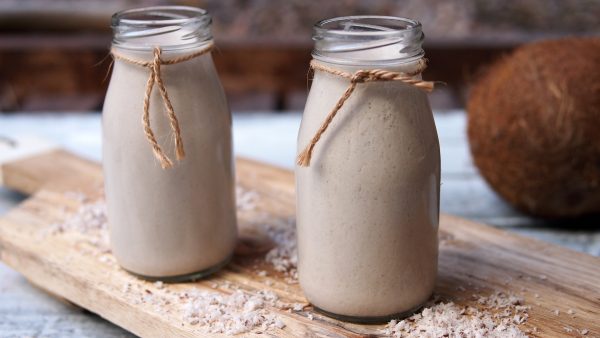Coconut Cream Recipe: If you’ve ever enjoyed a creamy Thai curry, a rich tropical dessert, or a refreshing smoothie with a velvety texture, chances are coconut cream played a key role in that recipe. Coconut cream is one of the most versatile ingredients in cooking and baking, adding richness, natural sweetness, and a unique tropical flair to both sweet and savory dishes. Unlike heavy dairy cream, coconut cream is plant-based, making it an excellent alternative for vegans, those who are lactose intolerant, or anyone simply wanting a healthier option in the kitchen.
This guide will walk you through everything you need to know about making coconut cream from scratch, the ingredients you’ll need, and a detailed step-by-step method. You’ll also learn about variations, tips, and delicious ways to use coconut cream in your favorite recipes. By the end of this article, you’ll be ready to create your own fresh, creamy coconut goodness at home.
Introduction to Coconut Cream
Coconut cream has been used for centuries across tropical regions where coconuts grow in abundance. It’s a staple in Southeast Asian, Caribbean, Indian, and Polynesian cuisines, where it’s celebrated for its ability to transform a dish with rich flavor and creamy texture. Unlike coconut milk, which is thinner, coconut cream is thicker, richer, and more concentrated.
Think of it this way: if coconut milk is similar to regular milk, coconut cream is like heavy whipping cream. It’s perfect for thickening curries, adding body to soups, and creating indulgent desserts like coconut cream pies or dairy-free whipped cream.
What is Coconut Cream?
Coconut cream is the thick, fatty portion extracted from mature coconut flesh. When grated coconut is soaked in hot water and squeezed, the first pressing gives coconut cream, which is thick and rich. Subsequent pressings with added water result in coconut milk, which is thinner. This is why homemade coconut cream is often richer and more flavorful than canned versions.
Benefits of Using Coconut Cream in Recipes
- Rich Flavor: Coconut cream enhances both sweet and savory dishes with a natural tropical taste.
- Dairy-Free Alternative: Ideal for people with lactose intolerance or those following vegan diets.
- Nutritional Value: Contains healthy fats, vitamins, and minerals that benefit overall health.
- Versatility: Can be used in curries, desserts, smoothies, and even coffee.
- Easy to Make at Home: With just one main ingredient—coconut—you can prepare fresh coconut cream without preservatives.
Ingredients You’ll Need
Before jumping into the preparation, let’s make sure you have everything ready. Coconut cream can be made with simple ingredients, and you probably won’t need to visit a specialty store if you live in a place where coconuts are accessible.
Fresh Ingredients for Authentic Flavor
The key to making authentic coconut cream is using fresh mature coconuts. Look for coconuts that are:
- Heavy for their size (indicating they’re full of water and flesh).
- Without cracks or mold on the shell.
- With clear liquid when shaken.
You’ll need:
- 1–2 mature coconuts (depending on how much cream you want).
- Warm water (to help extract the cream).
Alternative Ingredients (Store-bought Options)
If fresh coconuts aren’t available, you can still make coconut cream using:
- Unsweetened shredded coconut (desiccated coconut works well).
- Canned coconut milk (chilled, so the cream rises to the top for scooping).
- Coconut cream cans (ready-made, but check labels for additives).
Tools and Equipment Required
- A hammer or mallet (to crack the coconut).
- A knife or coconut scraper (to remove the flesh).
- A grater or blender (to process the coconut).
- A cheesecloth or nut milk bag (for straining).
- Bowls for collecting the cream.
Having these tools on hand will make the process smoother and less messy.
Step-by-Step Guide to Making Coconut Cream
Making coconut cream at home may sound like a challenge, but once you know the steps, it’s simple and straightforward. It’s all about patience and technique.
Step 1 – Selecting the Right Coconut
Choosing the right coconut is the foundation of this recipe. A mature coconut with thick flesh is best because it yields more cream than young green coconuts, which are mostly water. Tap the coconut with your hand—if it sounds full and sloshy inside, it’s likely a good one.
Step 2 – Cracking and Preparing the Coconut
Use a hammer or the back of a heavy knife to crack the coconut open. Drain the coconut water into a separate bowl (don’t throw it away—it’s refreshing to drink or use in smoothies). Once split, scoop out the white flesh carefully.
Step 3 – Grating or Blending the Coconut Flesh
Traditional methods involve hand-grating the flesh with a scraper, but a blender or food processor works faster. Add warm water to the grated coconut to help release the cream. Blend until you get a thick, pulpy mixture.
Step 4 – Extracting the Coconut Cream
Place the blended coconut mixture into a cheesecloth or nut milk bag. Squeeze firmly to extract the thick white liquid—this is your coconut cream. The first squeeze yields the richest cream, while subsequent squeezes produce thinner coconut milk.
Step 5 – Storing and Preserving Coconut Cream
Transfer the coconut cream into a clean glass jar. Store it in the fridge for up to 3–4 days or freeze in ice cube trays for long-term use. Homemade coconut cream does not contain preservatives, so always check for freshness before using.
Variations of Coconut Cream Recipes
Coconut cream is not a one-size-fits-all ingredient. Depending on the dish you’re making, you can adjust the preparation to suit sweet or savory flavors.
Sweetened Coconut Cream
Perfect for desserts, this variation involves adding sugar or honey to your fresh coconut cream. It’s ideal for pies, puddings, and frostings.
Coconut Cream for Savory Dishes
For curries and soups, keep the coconut cream unsweetened. You can also add a pinch of salt to bring out its natural flavors.
Vegan and Dairy-Free Alternatives
If you can’t access fresh coconuts, use unsweetened shredded coconut and warm water. Blend and strain to achieve a creamy, dairy-free substitute for store-bought cream.
Creative Uses of Coconut Cream in Cooking
Coconut cream is one of those magical ingredients that can instantly elevate any dish. Whether you’re whipping up a decadent dessert, preparing a comforting curry, or blending a refreshing drink, coconut cream adds richness and depth like no other. Its versatility makes it a must-have in every kitchen, especially for those who love experimenting with tropical and international cuisines. Let’s dive into some creative ways you can use coconut cream to transform your meals.
Coconut Cream in Desserts
Desserts are where coconut cream truly shines. Its natural sweetness and creamy texture make it the perfect alternative to dairy cream. You can use it to make:
- Coconut cream pie – A silky custard base enriched with coconut cream and topped with fluffy whipped cream.
- Dairy-free ice cream – Blend coconut cream with fruits like mango, banana, or pineapple for a tropical, creamy ice cream without the dairy.
- Coconut whipped cream – Chill your coconut cream, whip it up, and use it as a topping for cakes, cupcakes, or hot cocoa.
The best part is that coconut cream doesn’t just add flavor; it also brings a luscious mouthfeel that makes desserts extra indulgent without being heavy.
Coconut Cream in Curries and Soups
In savory cooking, coconut cream works wonders. Southeast Asian curries often rely on it to achieve that signature richness and balance of flavors. Add a generous spoonful to:
- Thai green curry or red curry for creaminess and mellowing the heat.
- Indian-style kormas to create a rich, aromatic sauce.
- Soups like pumpkin or sweet potato soup to add body and a hint of sweetness.
Coconut cream doesn’t just thicken the dish—it also ties together spices beautifully, making the flavors more cohesive.
Coconut Cream in Smoothies and Drinks
If you love tropical drinks, coconut cream will become your new favorite addition. Blend it into:
- Smoothies with bananas, pineapples, or mangoes for a creamy, tropical treat.
- Cocktails like Piña Coladas for that luxurious texture.
- Hot beverages like coffee or hot chocolate as a dairy-free creamer.
Adding coconut cream to drinks makes them smoother, richer, and far more satisfying. It’s like turning a simple beverage into a vacation in a glass.
Tips and Tricks for Perfect Coconut Cream Every Time
Even though coconut cream is simple to make, there are a few things you can do to ensure it comes out perfect every single time. Getting the right texture, flavor, and consistency can make a big difference in your cooking.
How to Make Coconut Cream Thicker
If your coconut cream comes out too thin, don’t worry—it’s easy to fix. Try these methods:
- Use less water when blending the coconut flesh.
- Let the cream sit in the fridge; the thick cream rises to the top and can be scooped out.
- Simmer the cream on low heat to evaporate excess water (just be careful not to scorch it).
Common Mistakes to Avoid
- Using young coconuts: These are great for coconut water but not for cream, since their flesh is too soft and watery.
- Adding too much water: This dilutes the cream and makes it more like coconut milk.
- Not straining properly: Failing to strain the pulp leaves bits in your cream, making it grainy instead of smooth.
How to Enhance Flavor Naturally
Sometimes, your coconut cream may need a little flavor boost. Try:
- Adding a pinch of salt to enhance the natural sweetness.
- Infusing with vanilla or cinnamon for dessert recipes.
- Mixing in lime zest for tropical dishes.
These simple tweaks can take your coconut cream from good to absolutely mouthwatering.
Nutritional Value of Coconut Cream
Coconut cream isn’t just delicious—it also offers nutritional benefits when enjoyed in moderation. Understanding its nutritional profile helps you make the most of it in your diet.
Calories and Macronutrients
Coconut cream is calorie-dense because of its high fat content. A typical 100-gram serving contains:
- Calories: ~330
- Fat: ~35 grams (mostly saturated fat)
- Carbohydrates: ~6–7 grams
- Protein: ~3 grams
It’s not a low-calorie food, but it’s filling and satisfying, making it great for recipes where richness is needed.
Health Benefits of Coconut Cream
- Good source of healthy fats: Contains medium-chain triglycerides (MCTs), which may boost metabolism and provide quick energy.
- Vegan-friendly: A perfect plant-based substitute for dairy cream.
- Rich in nutrients: Provides small amounts of iron, magnesium, potassium, and vitamin C.
- Supports digestion: Coconut fats are easier to digest for many compared to dairy fats.
Possible Drawbacks to Consider
- High in saturated fat: Overconsumption may affect heart health, so moderation is key.
- Calorie-heavy: Not ideal if you’re on a strict calorie-controlled diet.
- Store-bought versions: Often contain preservatives, thickeners, or added sugars—always check the label.
When used wisely, coconut cream can be both a flavorful and nutritious addition to your meals.
Storing and Preserving Coconut Cream
One of the most important things to know about coconut cream is how to store it properly. Since it doesn’t contain preservatives (especially if homemade), it’s more delicate than store-bought options.
Refrigeration and Freezing Tips
- Store homemade coconut cream in an airtight container in the fridge for up to 3–4 days.
- For longer storage, freeze it in ice cube trays and transfer the cubes to a freezer bag. This way, you can thaw only what you need.
- When refrigerated, coconut cream may separate into a thick layer on top and liquid at the bottom. Just stir before use.
Shelf Life of Homemade vs. Store-bought
- Homemade coconut cream: Lasts about 3–4 days in the fridge and up to 2 months when frozen.
- Canned coconut cream: Once opened, it should be used within 5–7 days and stored in a sealed container in the fridge.
Signs Coconut Cream Has Gone Bad
Always check before using:
- Smell: Sour or rancid odor means it’s spoiled.
- Texture: Separation is normal, but mold or clumps indicate spoilage.
- Color: Fresh coconut cream is white—any discoloration means it’s no longer safe.
Proper storage not only keeps your coconut cream fresh but also ensures your dishes remain safe and flavorful.
FAQs about Coconut Cream Recipe
1. Can I use coconut milk instead of coconut cream?
Yes, but keep in mind that coconut milk is thinner and less rich. If a recipe specifically calls for cream, milk may not provide the same texture.
2. How do I make coconut cream thicker?
Use less water when blending the coconut or refrigerate the cream to let the thicker portion rise to the top for scooping.
3. Is coconut cream the same as cream of coconut?
No. Coconut cream is unsweetened, while cream of coconut is sweetened and used mainly for desserts and cocktails.
4. Can I store coconut cream at room temperature?
No, homemade coconut cream should always be refrigerated or frozen. Leaving it at room temperature will spoil it quickly.
5. What can I substitute for coconut cream in recipes?
You can use heavy cream (if not vegan), cashew cream, or even thick Greek yogurt as alternatives, depending on the dish.
Conclusion
By following this step-by-step guide, you now know how to make coconut cream from scratch, how to store it properly, and how to use it creatively in your cooking. It’s an ingredient that not only boosts flavor but also adds nutritional benefits when consumed in moderation. So, next time you’re craving something creamy and delicious, skip the heavy cream and try coconut cream instead—you’ll be surprised at how much better your dishes taste.



